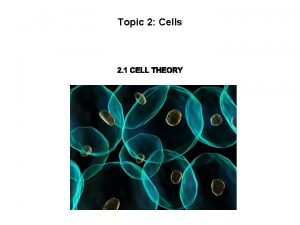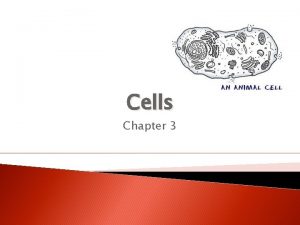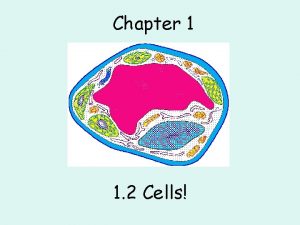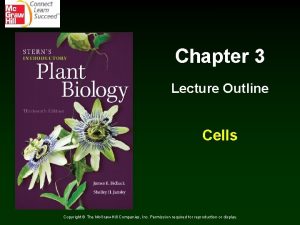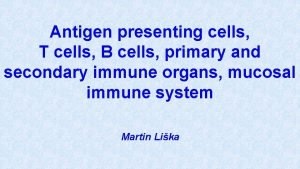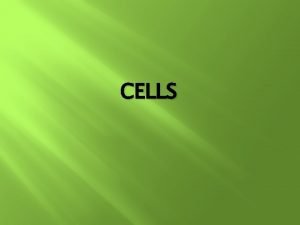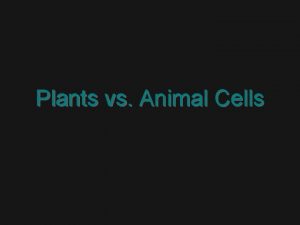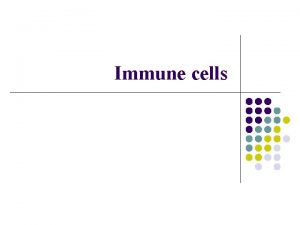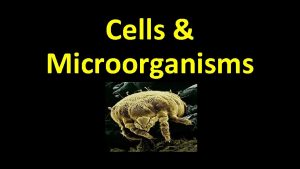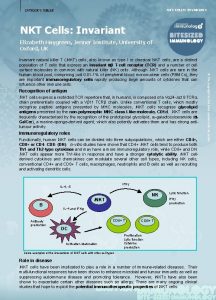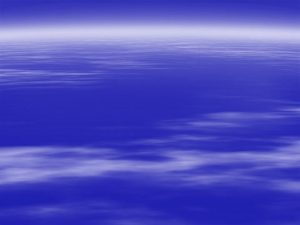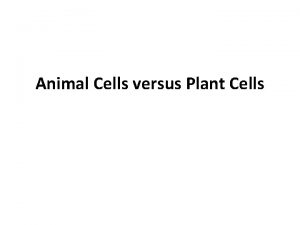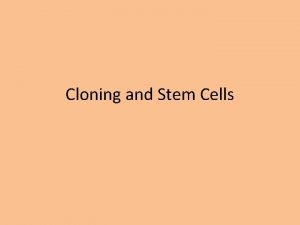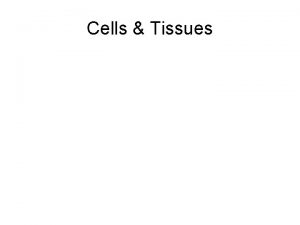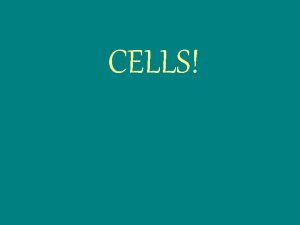Chapter 3 Lecture Outline Cells Copyright The Mc







































- Slides: 39

Chapter 3 Lecture Outline Cells Copyright © The Mc. Graw-Hill Companies, Inc. Permission required for reproduction or display.

Outline v History of Cell Theory v Modern Microscopes v Eukaryotic and Prokaryotic Cells v Cell Structure and Communication v Cell Components v Cellular Reproduction

History of Cell Theory v 1665 - Cells discovered by Robert Hooke. v Cell Theory: (1838) ** VIRUSES DUE NOT HAVE CELLS. Are they ALIVE?

Modern Microscopes v Light Microscopes - Increase magnification as ______ passes through a series of ______. • Compound Microscopes: – Distinguishes 2 micrometers and larger – Magnifies 1500 x • Dissecting Microscopes (Scanning Microscopes) – Three-dimensional viewing of opaque objects – Magnifies 30 x

EUKARYOTIC VERSUS PROKARYOTIC CELLS v ALL CELLS HAVE: CLASSIFIFICATION BY TYPE OF CELLS: Prokaryotes - Cells lack a ___________ • Type of Organisms = _____ Eukaryotic - Cells contain a __________ • Type of Organisms ____________ • Organelles - Membrane-bound bodies found which each have a particular function within eukaryotic cells • PLANTS– have ______

Cell Structure and Communication in Plants v v Cell Wall surrounds protoplasm. Protoplasm = ___________ Cell (Plasma) Membrane & Cytoplasm. = • Bound by plasma membrane – Cytoplasm consists of all cellular components between the _________________. o Cytosol - _____________ o Organelles - ___________ « Most, but not all, are bound by membranes.

PLANT CELL Drawing of plant cell

Cell Size v Higher plants--length between 10 -100 mm m Cell of Plant, Elodea

CELL WALL v FUNCTION: ____________ v STRUCTURE: Main biochemical is? • Also contains: – Hemicellulose – function = _________ – Pectin - _________________ – Glycoproteins ______________

• Middle lamella • first part produced; • Contains: ______________ LOCATION: _____________ Shared by: __________ v v primary walls Secondary walls: • What cells have & why? ________ • Additional component: ________ • Location ______ Secondary cell wall structure

COMMUNICATION THROUGH CELL WALLS • Plasmodesmata = ___________ – FUNCTION: ______________

PLASMA MEMBRANE v Plasma Membrane: • FUNCTIONS: ________________ • Biochemical Composed of: ________ – Orientation of double layer • OTHER COMPONENTS: – __________ Fluid mosaic model _____________

NUCLEUS v Nucleus: • FUNCTIONS: • STRUCTURE – Nuclear Envelope: – Nuclear Pores: – Nucleoplasm plant cell

• Nucleoli - Composed primarily of RNA • Chromatin Strands – Composed of: – Become:

• Chromosomes – Chromatids = – Centromeres = o Kinetochore = protein complex « location = o Spindle fibers (made of microtubules): function =

RIBOSOMES v Ribosomes • COMPOSITION: • STRUCTURE: • FUNCTIONS:

ENDOPLASMIC RETICULUM v Endoplasmic reticulum • Structure: • 2 Types

v Rough ER: has • FUNCTIONS: v Smooth ER • FUNCTIONS: Endoplasmic reticulum and ribosomes

v MICROBODIES, VESSICLES: • Structure: EXAMPLES • Transport • Peroxisomes - Serve in Hot conditions

v VACUOLES– Central Vacuole: 90% water • Tonoplast: • Cell Sap: – Contains dissolved substances – FUNCTIONS: o o Anthocyanins (red, blue, purple)


DICTYOSOMES v Dictyosomes, Golgi Apparatus • STRUCTURE: • FUNCTIONS:

– – EXPORT OF Substances in VESICLES o Migrate o Fuse o Secrete Examples: cell wall components, nectars, and oils.

MITOCHONDRIA v Mitochondria– Overall Function: • STRUCTURE – Cristae. – Matrix Drawing of a mitochondrion – AEROBIC RESPIRATION: C 6 H 12 O 6 + O 2 - CO 2 + H 2 O + ENERGY ATP

CYTOSKELETON v Cytoskeleton: • General Function: TYPES • Microtubules: – Functions: o Move cellulose for: Cell Wall

Microtubules … - Functions … o Found in flagella and cilia for: o Found in spindles for: in • Microfilaments - Role in cytoplasmic streaming

PLASTIDS v Plastids = v CHLOROPLASTS: • STRUCTURE: – Membrane – Grana and thylakoids

TEM and drawing of chloroplast structure Structure … Stroma: Small circular DNA molecule: Replication: EQUATION: CO 2 + H 2 O + Light Energy + Chlorophyll -- C 6 H 12 O 6 + O 2 + H 2 O.

Plastids … v v CHROMOPLASTS – Structure – Function: LEUCOPLASTS – Structure – Amyloplasts: – Elaioplasts: Chromoplasts in red pepper cells Amyloplasts in Potato cells

Cellular Reproduction & The Cell Cycle v Cell Cycle = • Divided into: ONION ROOT TIP– with cells in various stages of Interphase and phases of Mitosis

v Interphase: • Amount of Life Cycle? STAGES – G 1 = 1 ST GROWTH: – S = SYNTHESIS: – G 2 = 2 nd GROWTH: Interphase & Mitosis in Onion Root Cells

MITOSIS v Mitosis = • Produces: number of cells • Location in Plants: • Is a continuous process-- 4 phases:

v Prophase • Chromosomes o Spindle fibers « collectively spindle o Nuclear envelope and nucleolus:

Prophase v Metaphase • Chromosomes align: Metaphase

v Anaphase • Spindle fibers: • Chromosomes & Sister chromatids: • Daughter Chromosomes. Anaphase

v Telophase • Nuclear envelope & Nucleoli: • Daughter chromosomes: • Spindle fibers: • Cytokinesis: – Telophase cell plate: Cell plate formation

Review v History of Cell Theory v Modern Microscopes v Eukaryotic and Prokaryotic Cells v Cell Structure and Communication v Cell Components v Cellular Reproduction

Onion Root

Elodea Leaf
 Nondisjunction in meiosis
Nondisjunction in meiosis 01:640:244 lecture notes - lecture 15: plat, idah, farad
01:640:244 lecture notes - lecture 15: plat, idah, farad Olfactory groove keros classification
Olfactory groove keros classification Loop of henle
Loop of henle Thyroid parafollicular cells
Thyroid parafollicular cells Gamete vs somatic cell
Gamete vs somatic cell Why dna is more stable than rna
Why dna is more stable than rna Red blood cells and white blood cells difference
Red blood cells and white blood cells difference Prokaryotic versus eukaryotic
Prokaryotic versus eukaryotic Animal rights and animal welfare venn diagram
Animal rights and animal welfare venn diagram Prokaryotic vs eukaryotic cells venn diagram
Prokaryotic vs eukaryotic cells venn diagram The organelle trail
The organelle trail Masses of cells form and steal nutrients from healthy cells
Masses of cells form and steal nutrients from healthy cells Younger cells cuboidal older cells flattened
Younger cells cuboidal older cells flattened 4 types of eukaryotic cells
4 types of eukaryotic cells Are red blood cells prokaryotic
Are red blood cells prokaryotic Cell substance
Cell substance Lecture outline example
Lecture outline example Lecture outline example
Lecture outline example Lecture outline example
Lecture outline example Lecture outline meaning
Lecture outline meaning Outline one therapeutic use of stem cells
Outline one therapeutic use of stem cells Sentence outline examples
Sentence outline examples Hình ảnh bộ gõ cơ thể búng tay
Hình ảnh bộ gõ cơ thể búng tay Slidetodoc
Slidetodoc Bổ thể
Bổ thể Tỉ lệ cơ thể trẻ em
Tỉ lệ cơ thể trẻ em Chó sói
Chó sói Chụp phim tư thế worms-breton
Chụp phim tư thế worms-breton Hát lên người ơi alleluia
Hát lên người ơi alleluia Các môn thể thao bắt đầu bằng từ đua
Các môn thể thao bắt đầu bằng từ đua Thế nào là hệ số cao nhất
Thế nào là hệ số cao nhất Các châu lục và đại dương trên thế giới
Các châu lục và đại dương trên thế giới Công thức tính thế năng
Công thức tính thế năng Trời xanh đây là của chúng ta thể thơ
Trời xanh đây là của chúng ta thể thơ Mật thư tọa độ 5x5
Mật thư tọa độ 5x5 Phép trừ bù
Phép trừ bù Phản ứng thế ankan
Phản ứng thế ankan Các châu lục và đại dương trên thế giới
Các châu lục và đại dương trên thế giới Thể thơ truyền thống
Thể thơ truyền thống





















